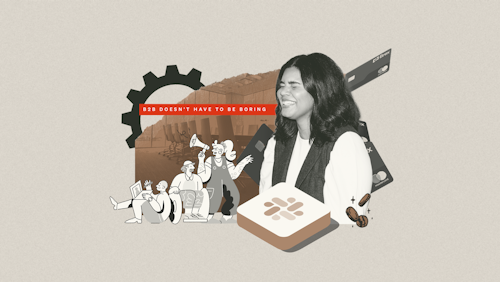Mergers & Acquisitions
The Brand Way to M&A: Part Three — Go to Market Better than Before

The scene goes something like this: A man, switch in hand, readies everyone for the big reveal. He's dragged his family out into the dark and the snow; they are cold. He's almost ready to flip the switch — his family's ready to go back inside — but first, a drum roll. DadadadadaDADADADADAhhhhh! Then ... nothing. The sparks don’t fly. The lights don't blaze. The big letdown is on.
We believe this scene from National Lampoon's Christmas Vacation is instructive not only for its comedic value, but for the lessons it holds for a brand's rollout. What could Clark W. Griswold have done to ensure that his holiday extravaganza created the spectacle he sought? Could he have encouraged more buy-in from those around him — could he have asked them to help with the occasion? Could he have been more thorough with his inspection of every (electrical) asset? Did he rush the whole thing? And was he ready for any contingency? (He was not.)
These questions and more are particularly important for brand rollouts after mergers or acquisitions. Given all the coordination that must take place — and at a time when community and culture can still be in a bit of flux — leaders have to remind themselves and their colleagues of three things: be inclusive, be thorough, and be bold.
That last note — be bold — you’re ready for it. As we discussed in Part One of our series about branding post-M&A, we’ve laid the groundwork for our new brand by figuring out its architecture and the opportunities it brings to our customers. And as Part Two explained, we’ve addressed the internal culture pieces and narratives that we can all gravitate towards and grow with. Now in Part Three, our final article in this series, it’s time for the big swing. Let’s get to it.
Inclusiveness: roll out from the inside out
Let’s be clear: a rollout isn’t a single event. It’s more than a logo reveal. It’s more than the redesign of your homepage and a nifty new hero headline. It’s a process — and planning for it should begin the moment a rebranding project begins. We want to make a splash with a brand rollout — we need to tell a story — so we’ve got to dive in, together. Early and often, on and on.
Let’s start by asking ourselves — and those around us — some key questions. What do we want this rollout to look and feel like? Are we all clear on our new positioning and emerging messaging, and how it impacts our people? Generally, how is our workplace community feeling about our new brand and its impending debut?
The answers to these questions are much easier to come by (and much more useful) if we establish a brand rollout committee.
Keep the team small, but make sure it includes leaders from key areas of the business.
This is where sales, marketing, human resources, product development, and more can come together, have a voice, and get on the same page.
It’s where conversations about language and story and audience messaging points and color consistency and logo usage help the whole company get comfortable and get aligned.
Most importantly, it’s an invitation to (continue to) fall in love with the new brand.
To that last point, a brand rollout committee is especially useful as a post-M&A touchpoint, where people from across the (new) organization can rally around something exciting and get to know each other better. These emotional benefits translate into tangible payoffs — time, money, and resource savings — and keep our focus on two key things. First, growing the new brand (read: not trying to preserve an old one or keeping entities that don’t fit with your new architecture). Second, our customers (and sending them clear messages about what they can expect at present and in the future). The flip side, of course, is failing to achieve this two-prong focus, which can diminish resources, stymie growth, and confuse customers.
Finally, a representative brand rollout committee enhances the post-M&A, emerging employer brand. As we noted in the second part of this series, crafting elements like revised core messaging statements and new brand stories are the building blocks for a new culture employees can rally around. Now, the rollout committee gets to start playing with those elements, imagining how and where they can live. And the committee can begin to involve even more people across the company in this process by gathering input and ideas, and testing things and asking for feedback. The effect? Engagement. And an engaging, outward-facing employer brand. The benefits?
Decreased cost per hire, by up to 50%
Quicker time to hire, by up to 50%
Greater retention, by up to 28%
Competitive advantage, with upwards of 80% of employees and employers who believe culture attracts top talent
Thoroughness: boot the devil from the details
Here’s another benefit of that brand rollout committee: you’ve got a group of people who can put their hands on all of the brand assets. That means the new stuff, the stuff that needs updating, and some other stuff that you can probably do without.
Let’s talk about that last point for a minute. It can be tempting to want to update every asset — after all, there’s a lot of excitement around the new brand and a desire to display it full-blast for all to see. That’s the right energy, but execution is everything. And as we all know, the more moving parts we have, the more there is to manage. Attempts to deploy too many assets can result in the following:
Missed deadlines
Inconsistent applications of the new brand
Quality control issues (oops, that Error 404 page)
To avoid this, we suggest the following:
Make a list of every asset.
Scout out vendors — and turnaround times — early.
Depending on your needs and your team’s size, consider contracting out for rollout support.
Assign a project manager to help prioritize and slot assets.
Prioritize the everyday assets your customers and employees will use and see. (Yes, there’s still room for swag at rollout, but all the swag doesn’t have to be rolled out at once.)
Inherent in all of this planning and prioritization is, of course, participation. And that requires communication. We all know that employees will have a lot of questions during and after a merger or acquisition — they’ll wonder what future the new, combined entity will pursue and how it will look. There will be rumors, and a key consideration for the brand rollout committee and key leaders will be how to address these. Similarly, partners and investors will have more questions; some may want to be involved. There’s an art to informing stakeholders of what’s to come and including them — without letting them dictate and art-direct key branding and rollout decisions. Remember: your team has the expertise and knowledge of the new brand and how to apply it.
Boldness: big swings for the big stage
Communication. Participation. Preparation. Prioritization. Let’s think back to Clark Griswold’s botched rollout for a moment — and remember how he failed in these key areas. He opted for a rush job. He had too many assets to check and too few people to check them (it was just him and son Russ, after all). He made no attempt to involve other family members, much less give them a heads up about the occasion. But Clark did one thing right: he took a big swing.
At Focus Lab, we’ve been fortunate to partner with clients who’ve taken similar swings, but with much better execution. Look no further than Luminate, who was previously a multifaceted collection of brands that was anything but cohesive. Their associated brands included Variety and Billboard (so, lots of name recognition). And they had multiple partners — like record labels — to consider. In short, there were a lot of players. But here’s what Luminate did that made their rebrand and rollout a success:
Early on, involved key members from teams across the brand in its emerging strategy
Committed fully to the new brand, creating new core values, core messaging statements, and more
Clearly communicated the new brand’s creation, while celebrating and contextualizing its roots
Led with story because, early on, they’d taken the time to develop one
Ensured new brand elements (such as the Luminate platform) were consistently aligned and deployed
Picked a big stage (SXSW!) and publicly rolled out in a clear, coordinated, and compelling fashion
If you asked key leaders at Luminate about their rollout, they’d surely tell you there was stress involved. All rollouts can test the nerves. But what helped Luminate excel — in addition to the points above — was trust. Even though key leaders were working together for the first time, they collaborated, delegated, and challenged each other. There were open dialogues and frank conversations. And there was chemistry. Luminate approached their rebrand and their rollout as a team. The result? A rollout that reflected their internal culture — and invited more people to be on hand to help flip the switch for the big reveal.

